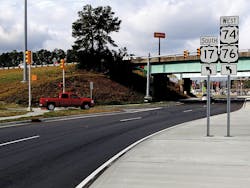By: Bill Wilson
The North Carolina Department of Transportation (NCDOT) needs to feel like a kid at a vegetable stand.
Up until this year, the NCDOT gazed upon candy that was stacked high . . . 12-high to be exact. That is how many mixes the state agency could choose from for an asphalt paving project. Now it is down to six and the temptation and stimulation has lowered significantly, but it was still a dozen when contractor S.T. Wooten was attempting to sweeten the ride on U.S. Rte. 17-74-76 in Brunswick and New Hanover counties, a prime beach route that was no picnic for commuters packing the corridor. NCDOT wanted to expand 1.7 miles of the four-lane road (two lanes in each direction) to six lanes with a 10-ft shoulder, as well as freshen the asphalt pavement and add a diverging diamond interchange. The existing road was suffering from surface cracking, and in order to fix it Wooten had to keep two lanes of traffic open at all times. Working under such an intense environment is not the healthiest of situations for any contractor, so Wooten decided to do most of the work, which included the widening of seven bridges, at night. The mix-juggling and challenging surroundings were handled with a high degree of success, leading to a 2017 Quality in Construction (QIC) Award from the National Asphalt Pavement Association.
“This was a hard job because on the other side of Wilmington [N.C.] it is kind of a funnel coming through there going south, and most of those people are going from north to south and are going to the beaches,” Chris Croom, division manager of Asphalt Quality Control and Materials for S.T. Wooten, told Roads & Bridges. “There was a lot of traffic and we had to deal with it.”
The route is a prime beach route in Brunswick and New Hanover counties.
Addressing the swamp
In the beginning, there was just a lot of swamp. The original 17-74-76 pavement was dropped on a swampy area, making the existing road feel more like a roller coaster, according to Croom: “The grade in general is not very good.” A sand filler was used to improve the grade as much as possible, and in order to remove the surface cracking Wirtgen 210 milling machines were put in action, digging down to a depth that ranged from 1.5 in. to as much as 3 in. Depending on the work load for a given day, S.T. Wooten often used two milling machines at a time. Deeper milling took place around eight different bridges.
“Normally when you are trying to get a good foundation at the bridge approach you need to do a little more milling and place new asphalt in that area to get a good structure underneath where you tie into the bridges,” Croom said.
An Astec Double Drum asphalt plant located 5 miles from the jobsite handled production. This particular plant has six silos, which allowed Wooten the ability to handle the changes in asphalt mixes called for by NCDOT project requirements.
“Switching mixes from base to intermediate to surface and back and forth is tough,” said Croom. “One of the biggest challenges for the asphalt plant was being able to produce a good and consistent mix while switching mixes that have different aggregate sizes and binder contents.”
Croom added the key was having as many as six silos handling the mix. If a change in mix was needed anytime during production, the mix transition was a smooth one which eliminated cross-contanimation of different types of mixes.
“We didn’t have any problems whatsoever with the test results of the mixes produced by the plant.”
Wooten produced over 66,000 tons of asphalt for the 17-74-76 job: 35,423.07 tons of surface, 15,404.05 tons of intermediate and 15,569.98 tons of base mix. The base mix contained a PG 64-22 binder and 30% reclaimed asphalt pavement (RAP). The intermediate mix contained a PG 58-28 binder where 30% and 40% RAP were used (PG 64-22 for virgin materials). The surface mix also carried 30% to 40% RAP and followed the same binder guidelines as the intermediate. The air voids of all the mixes fell around 4%.
The temperature of the asphalt coming out of the plant was 310°F. The material was transported to a Roadtec SB2500E Shuttle Buggy, which moved the asphalt, now about 290°F, over to a Caterpillar AP1000F asphalt paver with a 12-ft-wide screed. Two Caterpillar CB64B steel double-drum vibratory rollers and a Caterpillar CR30 roller handled compaction. The rollers made two passes in the static mode and two in the vibratory mode at 3,200 vibrations per minute. Target density was 92% of the max gravity, and Wooten was reaching 92.5% and 94%.
“Density was not really an issue at all,” Croom said. “It starts with the mix design. We design our own mixes and we design them with density in mind. Production is basically following the mix design. If the mix gradation or binder content gets off a little bit at times, we have to make adjustments to the mix occasionally to bring the volumetrics properties back in, which helps control density.”
S.T. Wooten had to keep two lanes of traffic open at all times during construction.
For the centerline joint, a wedge device bolted to the gate of the asphalt paver created a wedge on the joint side of the mat. An emulsion tack was applied before a 1½- to 2-in. overlap of mix was created, which was then compacted.
A Troxler 4640B nuclear gauge was used to check for density. Specifications required 2,000-linear-ft test sections, and within those test sections the contractor was required to take a shot with the nuclear gauge every 500 ft. The location of the shot was determined by a random number chart. The gauge had to be correlated by using a control strip, which consisted of 500 ft of asphalt at the beginning of the project or the beginning of paving with a new or different mix. Five cores were pulled and went to the lab and compared to the shots that were taken out in the field on the control strip. This allowed crews to calibrate the gauge. Cores were cut every 14 days or as required by NCDOT.
S.T. Wooten used a laser inertia profiler mounted to a pickup truck to check for smoothness. The results were promising.
“We did a good job, but you have so many bridges you have to tie into, so many ramps and loops coming off,” Croom said. “All of those areas will affect the ride quality.”
NCDOT also wanted Wooten to do some extra paving on the west side of the job. It added up to about three-quarters of a mile and the crew still finished on time.
“In that particular area . . . that is where you have a lot of loops and ramps coming down off the mainline into the causeway so it was not a huge deal to do that,” Croom said. “It should’ve been done because the pavement was in terrible shape.”
S.T. Wooten chose two consecutive weekends to build the DDI where S.R. 133 crosses 74-76. Traffic was rerouted and two rounds of 48-hour work was enough for completion.
In order to receive a QIC award, the section of pavement goes through a series of tests, with 75 composite score serving as the pass/fail mark. The composite score on this job was a 92, with the highest mark coming in density (95). Air voids came out to a 92, AC content was a 91 and gradation was 90.
“You want to make sure during the mix design phase that you don’t have a mix during productionthat is going to segregate easily. We make sure we design a mix that does not segregate easily,” added Croom.
About The Author: Wilson is editorial director of Roads & Bridges.





